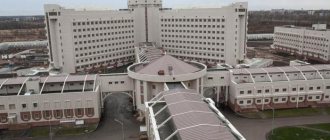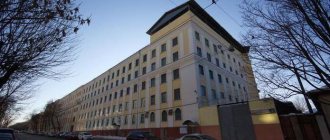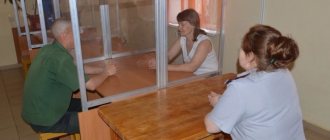American
In December 2010, after the elections, presidential candidate Vitaly Rymashevsky was sent to the KGB pre-trial detention center - “American”. This is how he described his camera:
“Immediately after signing the protocol, I ended up in a three-person cell, where I ended up being the fourth, so I slept not on a bunk, but on a special wooden board with a mattress. As my cellmates suggested, most likely the KGB was preparing for arrests on December 19 - these shields were new and stood in the corridor for several days before election day. And they also gave us new blankets, pillows and mattresses. The first cell in which I found myself after the arrest report was presented to me had a TV and a refrigerator, which were handed over from freedom to one of the cellmates. There was a washbasin, but no toilet - we were taken out twice a day to relieve ourselves. There was a bucket in the cell, but the inmates tried not to use it; they had to live and live there, but there was not enough space. In the second cell, where I spent the last 24 hours before my release, there was a toilet. There was no tank with drinking water; in the first chamber there was a filter with water, which came with the package, and in the second they drank water from the tap. It’s hard to even call what was in one of the cells a bathroom - it’s just a toilet in a cell.
The pre-trial detention center is built in such a way that you simply cannot see or hear a single person who is outside your cell. The guards did not talk, especially not to us; prisoners are also not allowed to talk in the corridor or courtyards. Thick and tall cameras make it difficult to understand what is happening behind them. And specifically, in order to exclude any possibility of communication (for example, shouting over the walls), Belarusian FM radio stations were turned on at full volume while walking in the courtyards. […] You can’t see anything from the window in the cell; on a walk, at best, you’ll see a piece of sky through the bars. Only when I was summoned for questioning by the investigator, through the window of his office I saw a piece of Independence Avenue. So I was able to at least glance down the street.
In the mid-nineties, journalist Alexander Stupnikov made a video about “American.” According to him, no one else filmed in this prison either before or after him. Most of the report shows the corridors of the pre-trial detention center, but a few shots are captured in the cells and showers themselves. The interlocutor in the uniform of a lieutenant colonel says that in 1990, a person under investigation escaped from the “American”, but was caught three weeks later.
At the end of the report there are words that are funny for 2020-21:
- ...And, perhaps, the most important thing: today, the replenishment of the “American” no longer depends on the instructions of government offices and the ideological predilections of officials.
Subscribe to our Instagram and Telegram!
Text : Alexander Lychavko
Cover:
Zhodino
The latest and loudest leak happened at the end of last December: one of the “inmates” managed to smuggle a smartphone into a pre-trial detention center cell in Zhodino and then take pictures of the interiors. He shared them with the Belarus Brain channel. In the photographs you can see 15-17 people at the same time sleeping not only on the shelves, but also on the floor and even under the table.
— After the arrival of a new wave of detainees, everyone was “received” in the corridor, after which they were distributed to cells. At this time, real chaos was happening, more than 60 people were standing against the wall, riot police were sitting on their smartphones and reading telegrams, and our evidence was simply lying on the floor. At this point, I managed to quietly pick up my phone and keys.
For all 15 days, the smartphone in the cell, despite daily searches, could not be found.
But the most important thing is that there were 18 people in the 10-bed cell on a permanent basis. Some had to sleep under the table or simply on the floor, huddled together. This is a gross violation of the rights of prisoners and is expressly prohibited by the International Covenant on Civil and Political Rights.
Of course, such a chance is one in a thousand, and modern photographs from inside a pre-trial detention center can be taken very, very rarely. But among the thousands of administratively arrested people there are people of all professions (only there have been no real cosmonauts yet) - and among them there are artists or people who simply know how to draw.
Last fall, the artist Vladislav Stalmakhov ended up in the same Zhodino pre-trial detention center. He called his 10 days of imprisonment “Zhodino plein air”, however, he painted his life as a prisoner after his release, from memory: in the cell he was not given a pen and paper.
- First we were taken in a cramped glass of a paddy wagon, then to the Leninsky District Department of Internal Affairs, there, in principle, everything was not bad. It was clear that they were fed up with all this, and they seemed to understand everything, but they couldn’t do anything... They brought a guy, beat him severely and marked him with paint. He, like the others, behaved with dignity. In Zhodino they made gestures at the reception, it was especially difficult for the young people.
Vladislav noted in the drawings that at first there were 24 people in the 8-bed cell, then 10 people in the 6-bed cell. He depicted not only the conditions of detention inside the cell, but also walks and even the food that was fed.
Once again Zhodino and again monochrome drawings, the author sat in September 2020. Here we already see a more detailed image of camera No. 6: a view towards the window and towards the door - and individual details.
And here is the Zhodino temporary detention center, a prisoner was there from December 23 to January 2 and celebrated the New Year in prison style, writes the Basta telegram channel. This time, a detailed plan of the camera was shared with people in the wild, taking into account the scale (it is indicated in the upper right corner). The terms are also indicated in prison jargon: “prodol” (corridor), “tram” (bench), “dolnik” (toilet) and so on.
Okrestina
Propagandists from state TV show “Potemkin detention centers” and how everyone lives well and amicably there. In mid-September, the STV channel aired a story about the famous “Akrestina”. Center employees say that there was no torture here and that the detainees were generally taken out for walks and even had doors opened for them for additional ventilation.
For Grigory Azarenka, the chief Evgeniy Shapetko conducted a tour of the TsIP.
— The minimum requirements that the legislation imposes on this kind of premises have been met. We see here beds, the presence of a heater (it works in winter), and the presence of a tap with hot and cold water. We see a sanitary facility, so there is no need to go anywhere to relieve natural needs.
We see benches and bedside tables where you can store your personal belongings. This is the minimum set of requirements that apply to this kind of premises. I say again: we are not a hotel, we are a place where people serve a certain sentence. We see bedding. Of course, when receiving people, all this is supplemented with personal hygiene products and bed linen. Their personal belongings, including bedding, are allowed. All this is allowed.
Here are a few camera shots of the old TsIP building on Akrestsin Street. In the mid-late 2000s, one student made them during a school excursion (!), and at the beginning of 2011, already being a “Young Front” member, he found them and shared them with journalists.
This is the same restroom that all the “inmates” complain about. The most unpleasant thing is that it is located directly opposite the “peephole”, into which the guards look every 5 minutes. Theoretically, this “peephole” cannot be closed, but practically most girls plug it with a piece of paper and quickly use a couple of free minutes until the warden indignantly opens the door to find out what the reason is.
On the right you can see the so-called “stage” - the place where the “prisoners” sleep and rest. The stage is wooden, no mattresses or linen are provided. The window from which light enters the camera is clearly visible. The cell, it is worth noting, has a very low ceiling - you can reach the window and look into it. In some cells the ceiling is so high that to look out the window you have to stand on the radiator and pull yourself up with your hands. Accordingly, there is significantly less light in such chambers.
Which metro has a toilet in Moscow?
Author of the question: Mukhin V. Created: 02/16/22
The cost of visiting the toilet is 60 rubles using a Troika card; you can only pay for the visit using this card. List of stations: VDNH, Mayakovskaya, Mendeleevskaya, Tsvetnoy Boulevard, Sokolniki, Komsomolskaya, Semenovskaya, Chekhovskaya, Chkalovskaya, Revolution Square, Taganskaya, Lenin Library, Park Kultury, Kropotkinskaya. It is also worth noting that on the MCC (Moscow Central Circle), every train is equipped with a toilet. The toilet is located in the first carriage of the train and is completely free for passengers.
Answered by: Markov K. 02/17/22
Volodarka
Six years ago, BT showed a 16-minute report about pre-trial detention center No. 1, that is, about the “volodarka”; there were also interviews with defendants in the cells. It is unknown whether they are being filmed in the same cells where they are sitting (with beds covered with mattresses and blankets) or in the cell from which the journalist Ekaterina Biretskaya herself picturesquely emerges (bare bunks without any bedding). The journalist also shows the basements of the Volodarka and says that entry here has been prohibited since 2008 (when one of the towers collapsed).
Several years ago, when blogger Alexander Lapshin was detained in Minsk on charges all the way from Azerbaijan, he was placed in a pre-trial detention center on Volodarsky, and hidden in the so-called “refrigerator”. Sergei Pavlovich, a Belarusian writer and former carder convicted of cybercrimes, described this “refrigerator” this way:
— The special corridor, also known as the s/c, is the most sinister place in the prison. Sixteen huts hidden behind an armored door with an electric lock, a separate guard. Particularly dangerous people sit here: rebels, leaders of organized crime groups, sentenced to the “tower” and simply those who need to be hidden very well. Meter-thick walls, through which not a single extraneous sound penetrates, vaulted ceilings - just like in the film “Ivan Vasilyevich Changes His Profession”, two single-tiered benches at a height of ten centimeters from the floor, an iron table, an iron cabinet for toiletries, a dolnyak in the corner and silence... deathly silence - neither the radio, nor the TV, nor the phone can be heard on the s/c.
The huts are located in the basement - the windows face the ground level. It’s very damp—clothes hung out to dry after a bath don’t dry out even after three days. There is no connection with the outside world and even with neighboring huts, it is impossible to work together - the windows are not closed with glass, like everywhere else, and not even with bars with “eyelashes” - blinds - there are at least five obstacles in the way of your “little one”: bars, glass, solid iron a sheet with holes the diameter of a cigarette, “eyelashes”, a “muzzle” shaped like an antediluvian Soviet air conditioner, and a metal mesh to top it off.
The temperature in the “refrigerator” in summer does not exceed 14 degrees. It is alleged that this is a photograph of that very “Volodar refrigerator”, however, the reliability of this statement is in question. But the basement punishment cell, which flashes for a second in the BT report, is similar to what we see in the picture.










